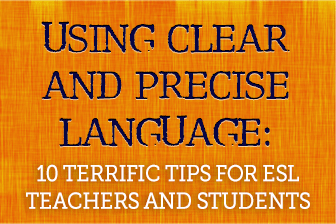Your students are learning complex grammatical structures. They are perfecting their pronunciation and learning how to listen better. Even their vocabularies are expanding, but something is missing.
You hear them using the same words over and over, bland words that may get the message across but certainly don’t make it interesting. You want to see them use precise language, pack more meaning in the same number of words. They want it too, even if they do not know it yet, and here are 10 terrific tips to get them to a place to achieve it.

Give Them the Tools
-
1
Thesaurus Rules
Using a thesaurus is as simple as using a dictionary, and your students probably already own that skill. Show your students what a thesaurus contains, how it is different from a dictionary, and how to use it. Make sure they know they can look up the synonyms they find in the thesaurus in the dictionary to get a more precise understanding of their meaning. Then make several thesauruses available in your classroom for students to use during independent writing time.
-
2
Expanded Vocabulary
If you teach ESL, you are going to be teaching vocabulary. But why not take your vocabulary lessons to the next level by giving not only the required words, but a synonym and antonym for each? Teaching groups of words rather than words in isolation will help your students develop a broader set of vocabulary and make more connections between the words that they learn, and that means they will be able to remember and use more words more easily.
-
3
Bank on It
You might also work together as a class to develop general word banks. Note which general words your students tend to use repeatedly (make, do, go, thing, easy, eat, etc.) and put word bank posters on display in your classroom. Whenever anyone finds or uses a more precise word for any of the general words on the posters (a synonym), add it to the list. Your students will always have words at their fingertips to use in place of the boring words when they look at the posters around the room!

Get Them Thinking
-
4
Journalistic Questions
If your students do not know what details to share when they are speaking or writing, how can they express those ideas precisely? To help them through these hurdles, teach your students how to generate ideas using journalistic questions. Have partners ask each other questions that start with who, what, where, why, when and how to encourage details when telling a story. Make sure your students know they can make notes as they answer their partner’s questions to use when they write later.
-
5
Use Your Senses
Another way to help your students think in detail is using sensory perceptions in descriptions. You may want to start by giving your students a list of descriptive words that can be used in association with each sense. (Something along the lines of taste: sweet, bitter, savory, appetizing, bland, buttery, acidic, etc.) Have your students imagine themselves in a place that they know. Ask them to note what it looks like, what is smells like, what they can hear and any other sensory details they can come up with. Encourage them to use words from your sensory word lists and be precise in what they describe.
-
6
Shed Some Light on Writing
For a teacher with a little creativity, there is no end to the use for highlighters. You can put them to the task of improving your students’ expressive language with a little help from your class. The next time you pair your students for peer review of writing, give each person a highlighter and have him note any particularly interesting or descriptive words in his partner’s piece. Then have students hand their papers back to the writer and look to see what their partner highlighted in their pieces.

Reward Creativity
-
7
Put Your Cards On the Table
You can make several games geared toward expanding and enhancing your students’ vocabularies. When you introduce synonyms and antonyms, use index cards to create a deck of matching pairs. Then use these cards for a memory style game or go fish.
-
8
Paybacks
Whenever a student discovers a specific or precise word, reward him! You may consider making a paper chain to hang around your classroom, adding one link at a time displaying an interesting word your students discover.
-
9
Bid Bye-Bye to Boring
Play a game of banishing boring sentences! Write a very generic sentence on the board (e.g. The person went there.) and challenge your students to rewrite the sentence in a creative way. Tell them that they cannot change the general meaning of the sentence, but they should get as creative as they can while still keeping the general meaning the same.
-
q
Deal With It
For a real challenge, take a set of vocabulary index cards and have each student choose two cards without looking at them. She must then write one sentence that uses both of the descriptive words. Each person scores 10 points every time he makes a logical sentence with his two descriptive words. See who has the most points after five rounds!
When students learn and use creative and specific language, they will be more motivated to continue doing just that.
Making vocabulary and language learning fun can mean all the difference between embracing boring words and ones that are breathtaking.
What boring words do your students use far too often?
P.S. If you enjoyed this article, please help spread it by clicking one of those sharing buttons below. And if you are interested in more, you should follow our Facebook page where we share more about creative, non-boring ways to teach English.







